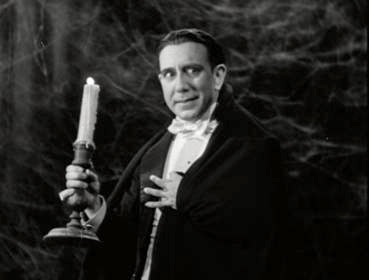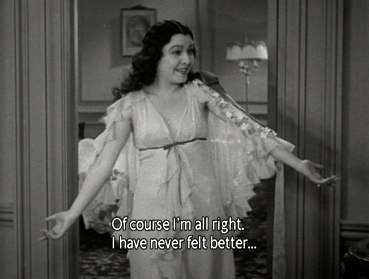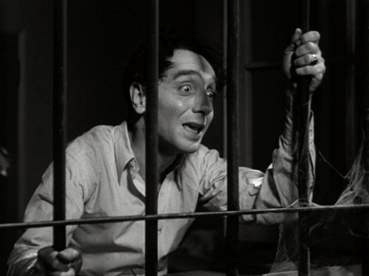|
Tod
Browning's 1931 film adaptation of Bram Stoker's seminal vampire
novel remains to this day the most famous and influential of all vampire
movies. Few, however, would claim that it's the genre's finest or even the best film adaptation of the novel – despite the long shadow it casts over the genre, I would
still rate Hammer's 1958 reworking of the tale and F.W. Murnau's silent Nosferatu considerably higher. And there's a third film, little seen
and made at the very same time as Browning's version,
that in many ways is also a superior work.
In
the early 1930s when sound cinema was still in its infancy, post-dubbing was an as-yet undeveloped
technology, and keen to cash in on the relatively small
but still lucrative Latin-American market, Universal
began filming Spanish language versions of some of their
features at the same time as the more widely seen English
language ones. Most of these are regarded as forgettable
at best. Drácula is the notable exception. The
arrangement was that Browning and his cast and crew would
film during the day, and when they headed home for the night, the cast and crew
responsible for the Spanish version would come in and, using
the same sets and equipment, work on their film. The story
goes that the first thing they would do is look at Browning's
footage from that day's shoot (given the time it took to process the film rushes, we can assume that they were actually a few days behind) and make a pledge to
better it. There has been much debate about this, but
the general opinion is, on a technical level at least, that they
succeeded. One thing is certain, the Spanish language Drácula is different enough
from Browning's film to be considered an important genre
work in its own right, and it even foreshadows developments
in the genre that English-language vampire films were not
to tackle for some considerable time.

Though
both crews were working from essentially the same script, the Spanish
version was to make enough significant changes to warrant
its own place in vampire movie history. Of course, its language
and limited market meant that it would not to prove to be as influential
as Browning's film, which was seen worldwide and re-popularised later through TV re-runs. But those responsible
for the Spanish version clearly had a good feel for where this newly born genre might be heading and were notably less
coy than Browning and his collaborators about expressing
it. Directed
by George Melford, a New Yorker with 113 films under his
belt and who spoke not a word of Spanish, the film is sometimes
credited as being co-directed by Enrique Tovar Ávalos,
who was effectively Melford's translator and the conduit
between the director and his Spanish-speaking cast. How
much Ávalos actually contributed to the look and
feel of the film is uncertain, but it should be noted that
this was only his fifth film in this role and was to prove his last.
Initially,
the two films seem almost identical – the opening title card may
be in Spanish, but it's otherwise almost the same
as its English-language counterpart. Even the opening scene
seems like a carbon copy, with the same coach ride, opening
lines and costumes, but it's not long before the two films part company. In Browning's
film this scene is over in 40 seconds, but in Melford's,
it runs for twice that length and provides the audience with considerably
more background information on why the locals live under a shadow of fear. This is a key element of this version of
the film – longer scenes in which characters expand on snippets
provided by the English language version. The result is
a film whose running time exceeds that of the
more commonly seen version by a considerable amount – where the Browning Dracula
is just 75 minutes in length, the Melford Drácula runs for 103 minutes. The trick is, though, it doesn't
feel longer.
The
story is effectively the same, as are all the major plot
points, but it's in the fine detail that the differences lie.
In narrative and subtextual terms, probably the first major
change comes when Renfield passes out and is attacked by
Dracula's brides. Here there is no intervention from the
Count, no moment in which he stamps his authority on the
women, and thus no hint of homoeroticism when Renfield is
'seduced' – the fact that all three brides descend on him
before the fade-out has its own, most interesting implications. Indeed, the sexual aspect of the vampiric attack
is brought much more to the fore here, and in its openness about the response of the victims, the film
really was ahead of its time. Whereas in the Browning version Mina mournfully tells Harker
that he can no longer touch her, Eva emerges from her bedroom
the morning after being bitten by the Count with all the energy and cheer of someone
who has had a night of stupendously good sex. It's an aspect emphasised by the costume design, which is far more
risque than the more censorship-fearing English language
version, never more so than in this very scene, where cleavage
is constantly on display, and – for the first part of the
scene at least – Eva's top is transparent enough for her nipples to be visible. There
is no question here – the whole scene is about sex. It concludes
with a moment entirely absent from Browning's film
(and the rest of Medford's) when Eva leans forward and
bites Harker hungrily on the neck. This is the second key
piece of vampire iconography missing from the English language
version to turn up here – an earlier close-up of two bite marks on Lucy's neck has no visual equivalent in a film where such marks are only referenced verbally.

This
kind of thematic enhancement is matched by a technical ambition
that often leaves Browning standing (and apparently annoyed
the hell out of him). The most famous example is
when Renfield first encounters Dracula, where Browning's static
camera is replaced by a dynamic crane shot that starts on a
distracted Renfield and then flies up the stairs to the Count,
who is standing, candelabra in hand, framed spectacularly
in front of a gigantic spider's web. Elsewhere, Melford counters the oft-spouted theory about the immobility of cameras in these early days
of sound by tracking in and out during
dialogue scenes. This is at its most effective during the sequence
in which Dracula attempts to control Van Helsing, only to have
the tables turned on him and be sent running from the room,
a moment that seems to directly anticipate the energy
of Christopher Lee's interpretation of Dracula in the later
Hammer version. Perhaps
the only alteration that plays less effectively than it does in Browning's film
is the extraordinary moment when Renfield slowly advances
on the fallen maid – once again it is very creepily done,
but here the action is seen through to its conclusion, where it's revealed
that Renfield has merely spotted a fly that had landed on
the girl's face and is attempting to creep up on it (it
gets away). This is one scene I wanted left to my imagination – I had come up with something much more bizarre.
Where
the Spanish film sometimes loses out to its English language
brother is in its lead performances. Carlos Villar's
Conde Drácula frankly makes Lugosi look a class act, hamming it up to a sometimes ludicrous degree, especially
when he approaches a victim to bite them. Similarly, as Van Helsing,
Eduardo Arozamena is nowhere near as commanding as Edward
van Sloane and spends much of the film looking either wildly
surprised or worried to the point of tears (that said, both
men some close to nailing it in the aforementioned
confrontation scene, which really works). Far better all
round is Pablo Álvarez Rubio as Renfield, who genuinely
gives Dwight Frye a run for his money as the demented madman
of the second half and for my money is actually superior
as the supposedly sane lawyer on his way to meet Dracula
in the opening scenes. He underplays the role nicely here
and comes across as a sensible man not persuaded by superstition
and keen to conclude his business, as opposed to the
exaggerated, wide-eyed naivety of Frye's interpretation. Equally convincing is Lupita
Tovar as Eva, especially the morning after her seeing-to
by Dracula, in which her energy and allure completely sell
the sexual aspect of this sequence.
Melford's
attention to detail includes the soundtrack. Although also
lacking a music score in the traditional sense, there are
music cues for a couple of the key appearances of Dracula
and the use of sound effects is sometimes memorable, from
the castle's monstrously creaking doors to the wind and
insane laughter on board the ship to England, a scene that
has a very real sense of terror-induced madness. Even more
impressive is the sometimes striking use of composition
and lighting, courtesy of cinematographer George Robinson.
Though many of the wider shots are straightforwardly (one
is reluctant to say blandly) lit, some close-ups and medium-shots
are beautifully done – Eva's head lying sleeping on her
pillow, Renfield in his cell illuminated by a single shaft
of moonlight, and night-time exteriors that use smoke and backlight
in a way that prefigures the gorgeous work done by Ted Scaife
on Jacques Tournier's 1957 Night of the Demon.

Whether
Melford's film is actually better overall than Browning's
is ultimately a matter of personal taste. It lacks the authorotative presence of Lugosi and Van Slone, is but otherwise dramatically every bit its equal,
and from a technical standpoint is an easy winner. It remains an essential companion piece to the
more famed English language version and a crucial work – sometimes
for different reasons to Browning's film – in the development
of the vampire genre.
Although
the same age as the English language Dracula,
the print on display here is noticeably superior; there
are still plenty of dust spots, a lot of flickering and
the odd bit of damage, but the detail level is very good
and the contrast is excellent throughout. Created from
a quality nitrate negative that Universal had stored in
their vaults, it really does look good, save for one reel,
which had to be transferred from an inferior, multigenerational
source because the film print had severely deteriorated
over time. This covers just a small section of the film,
but the drop in quality here is very marked. The picture
is framed in its original aspect ratio 1.33:1.
As
with the English language version, the sound is a tad fluffy
and there are very noticeable shifts in background noise
when dialogue suddenly kicks in, but there are no violent
pops or crackles, and on the whole this is perfectly serviceable
and easily the equal of its English language cousin.
It
should be noted that the English subtitles here are for
the deaf and hard of hearing, and the subtitles appear directly under
the person speaking, which can see them darting about the
screen a little and include announcements of sound effects.
On the original DVD release the subtitles were positioned at at
the bottom of the screen, as normal, and translated the dialogue only – with this option now removed
and only the SDH subtitles available, the original disk
remains my preferred version on that score alone. The French
subtitles are standard issue.
Previously
released as a feature-packed two-disk set, which has now been withdrawn and replaced by a quite
superb 2 disk set that features this film, the English language
version, Dracula's Daughter, Son
of Dracula and House of Dracula,
plus all the extras from that original release, most of
which relate to Browning's film. There is only one extra
specific to the Spanish version.
Introduction
to the Spanish Version by Lupita Tovar Kohner
precedes the main feature and features a 4 minute interview
with the star of the Spanish language version, who gives
a brief but intriguing insight into the production to this
edition of the film. I could have done with a lot more of
this.
For
anyone familiar with both the Tod Browning Dracula and (especially) the development of the vampire genre over
the course of the next fifty years, George Melford's Spanish
language Drácula is a revelation.
The performances of Carlos Villa and Eduardo
Arozamena as Count Dracula and Professor van Helsing lack
the commanding presence of Bela Lugosi and Edward Van Sloan,
but Pablo Álvarez Rubio is fine as Renfield and Lupita
Tovar makes for a sometimes erotically charged Mina. The
film's exploration of the sexual aspect of the story is
far bolder than in Browning's version and still looks years
ahead of its time – it's also faster paced, more technically
accomplished and more adventurous than its English language
cousin, and has to be the key inclusion on this excellent
5-film set. The only down side is the lack of a standard
English subtitle track, which was on the original release
and really should have been included here – hard-of-hearing
subtitles are a worthy inclusion, but for those of us who
merely need a translation of the Spanish, having the subtitles
jump around the screen and being told that there is a bell
ringing when we can plainly hear it is a little distracting.
|